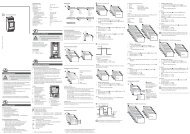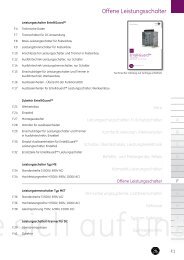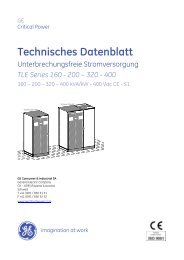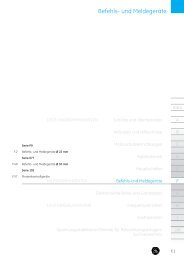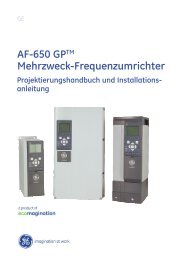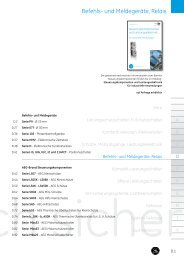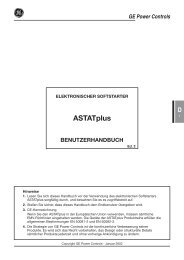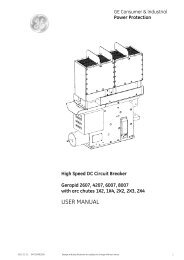High Speed DC Circuit Breaker - G E Power Controls
High Speed DC Circuit Breaker - G E Power Controls
High Speed DC Circuit Breaker - G E Power Controls
You also want an ePaper? Increase the reach of your titles
YUMPU automatically turns print PDFs into web optimized ePapers that Google loves.
3.2.3 Mechanism<br />
• The Gerapid is equipped with a modular designed<br />
mechanism, wear-resistant and nearly maintenancefree.<br />
This mechanism ensures an extended electrical<br />
and mechanical endurance of the breaker as well as a<br />
high amount of safety for all operation conditions.<br />
• This mechanism is mechanically latched in CLOSE position.<br />
The principle of a mechanical latch mechanism offers<br />
the big advantage, contrary to often used holding<br />
magnet system. No auxiliary control power source is required<br />
to keep close.<br />
• The mechanism is provided with two latches [Fig. 6]. One<br />
of the latches, “slow latch”, is used for opening under<br />
normal conditions, like actuation of shunt trip or zerovoltage<br />
release. The other one, “quick latch”, de-clutches<br />
the main contact arm from the mechanism and open<br />
contacts with an extremely short delay. This is used in<br />
case of short-circuit or overloads. All safety releases operate<br />
onto this latch.<br />
3.2.4 Over-Current Tripping device (code nr: 7)<br />
• The OCT device is a release magnet with twin magnet<br />
circuits, optimizing the twin magnetic field principle [Fig.<br />
7]. This technology ensures an equally fast tripping in<br />
both current directions.<br />
• The magnetic system does not require an auxiliary control<br />
voltage to operate. It uses magnetic energy from the<br />
main circuit.<br />
• The system consists of the holding circuit [6], the movable<br />
armature [3] and the tripping circuit [7]. The holding<br />
and the tripping magnetic circuits are both excited by<br />
main current [1]. Until the static overload release’s response<br />
threshold has been reached, the armature [3] is<br />
held in position by the holding flux (ΦH) [2] and the<br />
counter spring’s force [4]. Once the main current exceeds<br />
the set static response threshold, the attraction<br />
flux (ΦA) [2] takes over and pulls rapidly down the flexible<br />
armature [3]. During this operation, the armature hit<br />
the seesaw, which releases the quick latch in the<br />
mechanism. The latch and contacts are opened immediately.<br />
• The response threshold can be easily adjusted by turning<br />
the adjustment nut with a SW6 hexagon wrench as<br />
described in point 2.3.2.<br />
• In combination with the transparent side protection<br />
covers (code nr: 15), a fixed mounted insulated knob is<br />
available to enable OCT adjusting [Fig. 16].<br />
6<br />
Fig. 6 Latching and tripping system<br />
7<br />
1. Current flow direction.<br />
2. Magnetic core with two fluxes (holding flux ΦH and attracting flux ΦA).<br />
3. Movable anchor.<br />
4. Pressure spring for movable anchor.<br />
5. Short circuit rings.<br />
6. Holding magnetic circuit.<br />
7. Tripping magnetic circuit.<br />
Fig. 7 OCT device<br />
S47183-e 01/2008 Design and specifications are subject to change without notice 7





